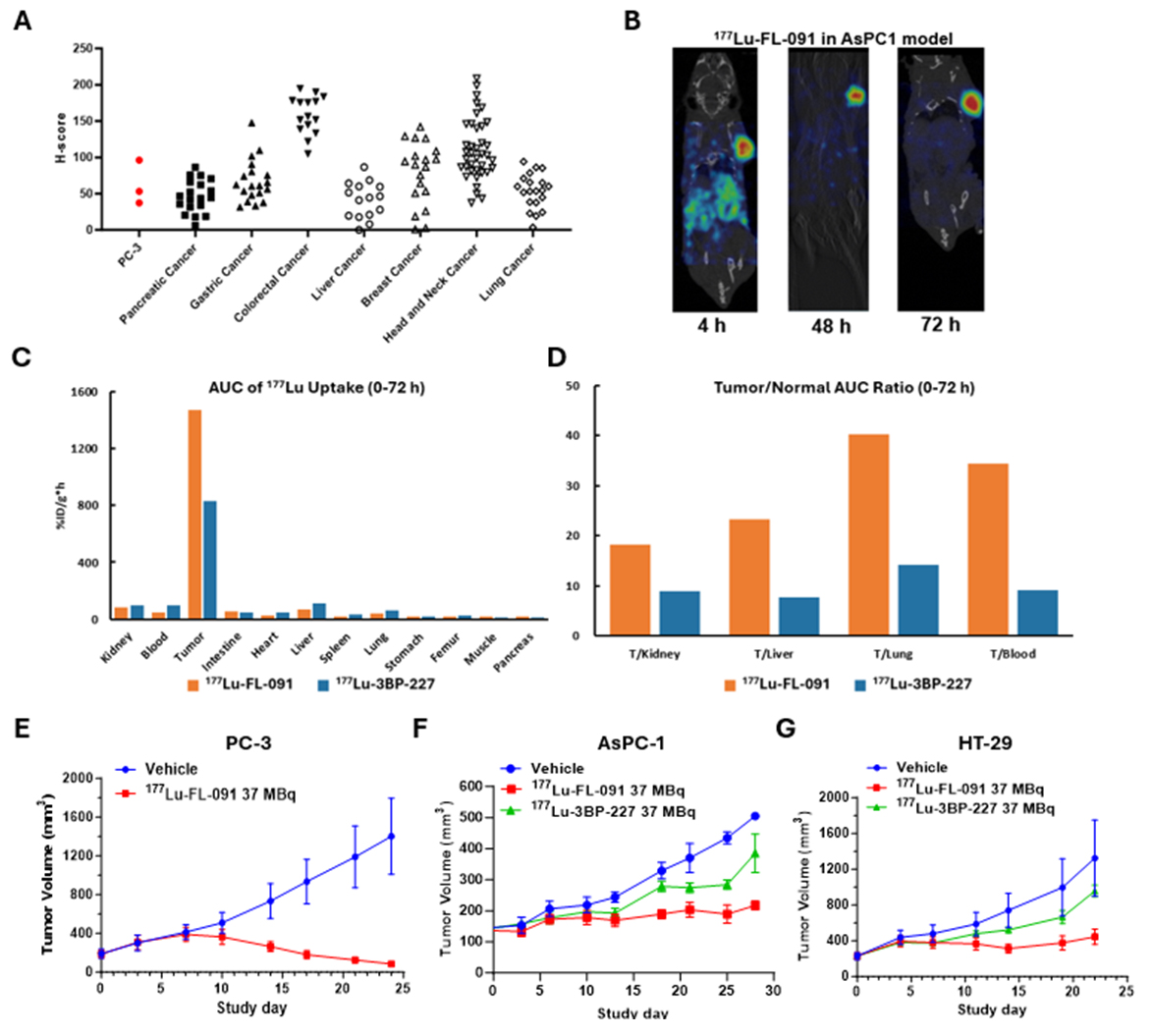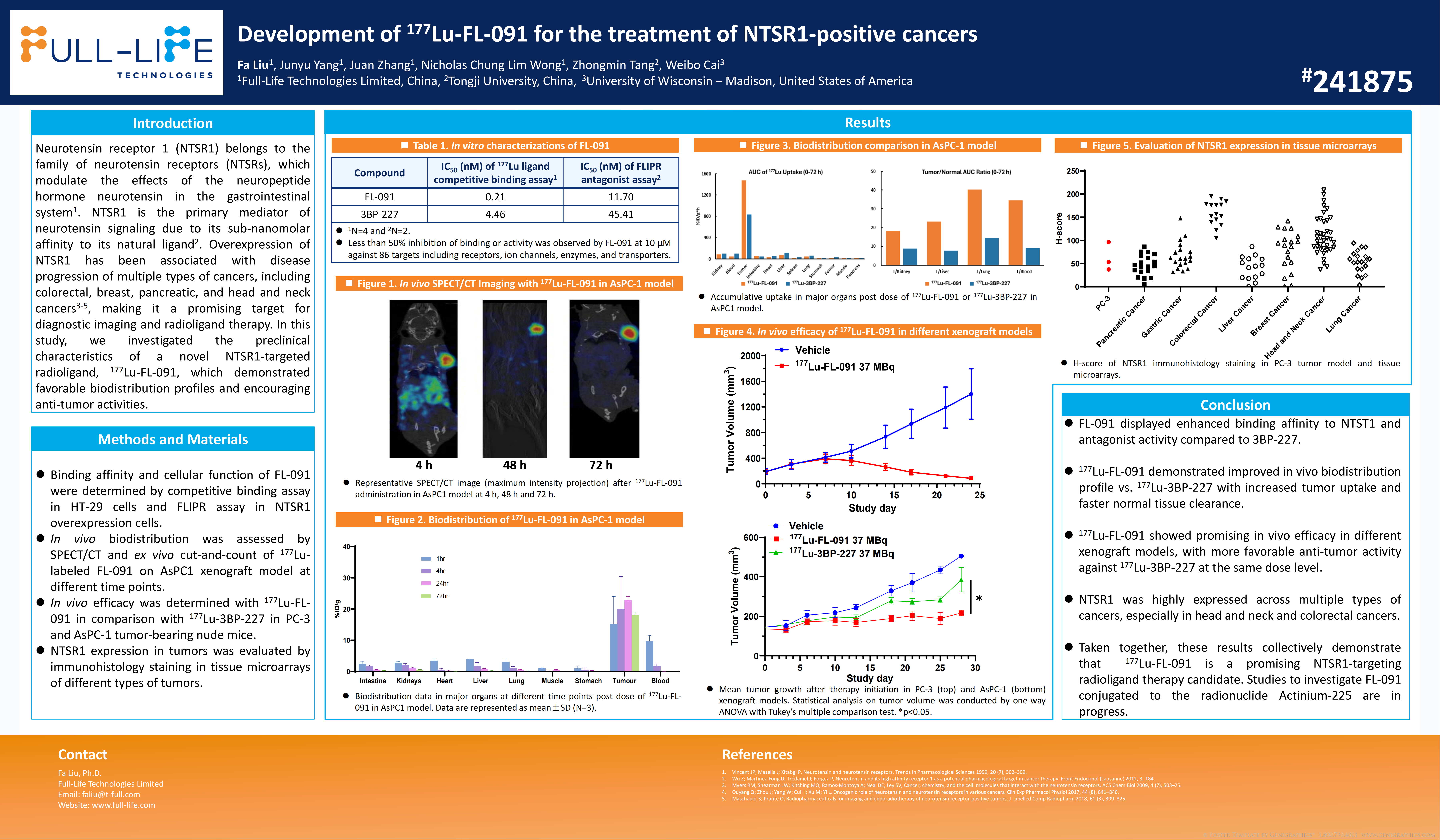
All Authors:
Fa Liu, Full-Life Technologies Limited (Primary Presenter)
Junyu Yang, Full-Life Technologies Limited
Juan Zhang, Full-Life Technologies Limited
Nicholas Chung Lim Wong, Full-Life Technologies Limited
Zhongmin Tang, Tongji University
Weibo Cai, University of Wisconsin - Madison
Purpose/Background:
Neurotensin receptor 1 (NTSR1) belongs to the family of neurotensin receptors (NTSRs), which modulate the effects of the neuropeptide hormone neurotensin in the gastrointestinal system. NTSR1 is the primary mediator of neurotensin signaling due to its sub-nanomolar affinity to its natural ligand. Overexpression of NTSR1 has been associated with disease progression of multiple types of cancers, including colorectal, breast, pancreatic, and head and neck cancers, making it a promising target for diagnostic imaging and radioligand therapy. In this study, we investigated the preclinical characteristics of a novel NTSR1-targeted radioligand, 177Lu-FL-091, which demonstrated favorable biodistribution profiles and encouraging anti-tumor activities.
Methods:
Most experiments were performed with a comparator, 3BP-227, a DOTA-conjugated NTSR1 antagonist vector whose 177Lu-labeled form has demonstrated anti-tumor activities in preclinical studies and also in compassionate use clinical cases. Protein expression of NTSR1 was evaluated by immunohistochemistry in tissue microarrays from tumor biopsies covering a variety of cancer types. 177Lu ligand competitive binding assay was used to evaluate the binding affinity of compounds in HT-29 cells. FLIPR antagonist assay was performed to determine the function of compounds in NTSR1 overexpression 293T cells. 177Lu-labeled compounds were evaluated by SPECT/CT and ex vivo biodistribution assays in mice bearing AsPC1 pancreatic cancer xenografts. The anti-tumor activity of 177Lu-labeled compounds was assessed in mice bearing PC-3 prostate cancer, AsPC-1 pancreatic and HT-29 colorectal cancer xenografts.
Results:
The NTSR1 positive rate ranged from 10.71% to 54.29% across different indications, with the highest rate in head and neck cancer and highest H-score in colorectal cancer (Figure A). For most evaluated indications, NTSR1 positivity in non-malignant tissues were 0%. In the 177Lu ligand competitive binding assay, FL-091 and 3BP-227 displayed IC50 of 0.21 and 4.46 nM, respectively. The IC50 values for FL-091 and 3BP-227 in FLIPR antagonist assay were 11.70 and 45.41 nM, respectively. High and sustained tumor uptake was observed for 177Lu-FL-091 in AsPC1 xenograft model with a fast clearance in normal organs (Figure B). 177Lu-FL-091 demonstrated improved biodistribution profile compared to 177Lu-3BP-227 in the AsPC1 mouse model, enabling about 2-fold higher tumor radiation load (C) and 2 to 4-fold higher tumor to normal organ ratios (Figure D). Most importantly, 177Lu-FL-091 exhibited promising in vivo anti-tumor activity in multiple xenograft models. In PC-3 xenograft model that was negative for AR or PSMA expression, single dose of 177Lu-FL-091 at 37 MBq induced >30% tumor shrinkage in all treated mice (Figure E). In AsPC-1 and HT-29 xenograft models, single dose of 177Lu-FL-091 at 37 MBq demonstrated superior anti-tumor activity to 177Lu-3BP-227 (p<0.05) at the same dose level (Figure F and G). Efficacy in all models was achieved without negatively affecting body weight and the treatment was well tolerated at the dose levels up to 148 MBq, suggesting a good safety profile of 177Lu-FL-091.

Conclusion:
NTSR1 was found to be highly expressed across multiple types of cancers, especially in head and neck and colorectal cancer. FL-091 displayed enhanced binding affinity to NTST1 and antagonist activity compared to 3BP-227. In addition, 177Lu-FL-091 demonstrated improved in vivo biodistribution profile vs. 177Lu-3BP-227 with increased tumor uptake and normal tissue clearance rate. In particular, 177Lu-FL-091 showed promising in vivo efficacy in different xenograft models , with more favorable anti-tumor activity against 177Lu-3BP-227 at the same dose level. Collectivelythe results suggest 177Lu-FL-091 as a promising radioligand candidate for the treatment of NTSR1 positive cancers.







